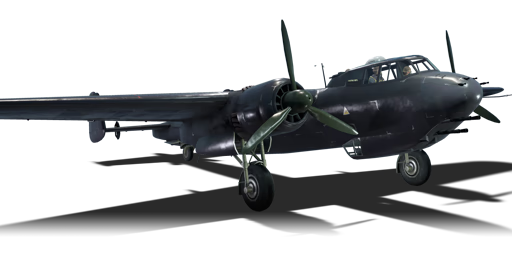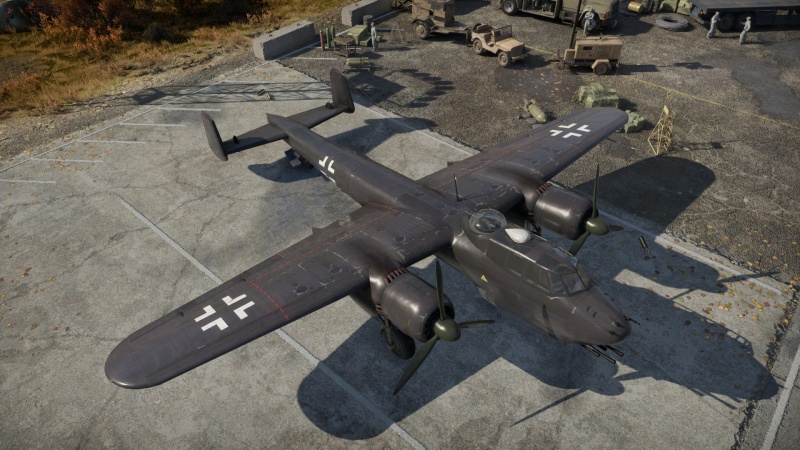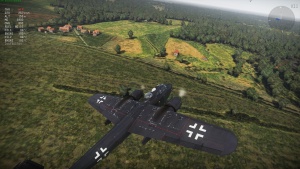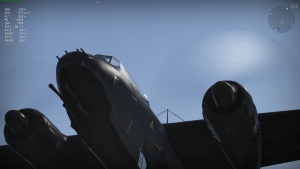Difference between revisions of "Do 217 J-1"
m (→External links) |
(→Usage in battles) (Tag: Visual edit) |
||
| Line 160: | Line 160: | ||
'''''Bomber interception'''''<br> | '''''Bomber interception'''''<br> | ||
After seeing how many guns this plane has, you might think that bombers will be easy to destroy. Well, to a certain degree, yes. The main flaw in this tactic that bombers are usually flying at altitudes you can't reach. Simple math tells you that 4.7 m/s is simply not enough. So, try to engage the low to medium height flying bombers. They are easy prey, but if they are covered by fighters, try to take those out by head-on attacks. Or at least have one wingman with you. | After seeing how many guns this plane has, you might think that bombers will be easy to destroy. Well, to a certain degree, yes. The main flaw in this tactic that bombers are usually flying at altitudes you can't reach. Simple math tells you that 4.7 m/s is simply not enough. So, try to engage the low to medium height flying bombers. They are easy prey, but if they are covered by fighters, try to take those out by head-on attacks. Or at least have one wingman with you. | ||
| + | |||
| + | * In Simulator, the Do-217 J is a good tool for getting used to the bomber-hunting playstyle. Its large size allows it to carry a heavy-punching armaments of 4x 20mm MGFF/M cannons plus 4x 7.92mm MG17 machine guns in the nose, with each holding plenty of ammunition. This firepower at its BR is something that cannot be ignored by any bombers. It can also carries 8x 50kg bombs, allowing it to perform some ground-pounding. However, the high weight of the Do-217 means that it has very slow acceleration and climb rate, which can make it hard to catch up to a target sometimes. Its lack of maneuverbility also strictly limits its targets to similarly heavy aircraft. Finally it has extremely restricted views due to the thick canopy frames and no glass towards the back at all. You even may need to use the gunner view like a bomber just to be aware of your surroundings. | ||
| + | * When taking off, you can use no flaps at all while you accelerate on the runway. This is quite a heavy plane, so you need to gather more speed before lifting off (flaps do generate lift but also decrease speed), and you will use more of the runway than other planes. Do not forget to counter the shift to the left by kicking the rudder to the right. Deploy takeoff flaps when you are above 200 km/h, and pull the stick back. This process can be harsher if there are obstacles at the end of the runway (eg. trees, houses). Upon being airborn immediately retract gear, and retract takeoff flaps when you are above 240 km/h. | ||
| + | * Getting to a target's altitude takes time and patience given the low climb rate or the Do-217. Ambush around friendly ground targets (eg. tank columns, artilleries, convoy, etc) or bomb bases (especailly half-finished bases) so there is a better chance of catching enemy bombers or ground-pounders. The Do-217 cannot really perform BnZ on a bomber since it is hard to quickly climb higher than them after spotting them, therefore you will usually engage the target aircraft at a similar altitude. Track the target aircraft with lead pursuit to close in faster. As afromentioned, the Do-217 J's sluggish flight performance does not allow much maneuvers when intercepting, thus you cannot utilise tactics such as deflection shooting as the turns involved bleed too much speed. It is best to just sit behind a bomber and carefully shoot at it, although this is not beneficial for the player to develop and practice the said tactics for later aircraft. Bombers at similar BR have weak defensive armaments which do little damage to the rugged Do-217 J. Open fire once the target's wingtips are about to fill up the aiming reticle completely. The big ammo pool for the cannons (200 RPG) allows some spray-and-pray, but it is still better to fire with 1-3 second bursts. The 4x 20mm cannons are very effecient at tearing off flaps, cracking open cooling systems and damaging engines, and common bombers around this tier will not survive long. The Do-217 J's turn rate allows it to keep up with most bombers should they maneuver to avoid the Dornier's guns, however against certain bombers (eg. SB2M) the Do-217 will get out-turned. These bombers, however, will also bleed speed and energy in a tight evading maneuver, allowing you to catch up. If they are out of your view, switch to gunner view to locate them. | ||
Here is the attacking the 217 part. If you meet 217 with a good fighter, engage it from the side. That will make him turn, in which case he will slow down, making him easy to destroy. If he tries to escape upwards, follow him. He can't climb very good. If he tries to dive, follow him also. You can achieve higher speeds and still manoeuvre better. Here is the important advice: if 217 tries to engage you head on, fly straight at him, but at 0.90 km before him, break into a turn of about 45 degrees left or right. He will try to turn, but he can't manoeuvre well. Then follow him and engage him from behind. | Here is the attacking the 217 part. If you meet 217 with a good fighter, engage it from the side. That will make him turn, in which case he will slow down, making him easy to destroy. If he tries to escape upwards, follow him. He can't climb very good. If he tries to dive, follow him also. You can achieve higher speeds and still manoeuvre better. Here is the important advice: if 217 tries to engage you head on, fly straight at him, but at 0.90 km before him, break into a turn of about 45 degrees left or right. He will try to turn, but he can't manoeuvre well. Then follow him and engage him from behind. | ||
| Line 235: | Line 239: | ||
== See also == | == See also == | ||
''Links to the articles on the War Thunder Wiki that you think will be useful for the reader, for example:'' | ''Links to the articles on the War Thunder Wiki that you think will be useful for the reader, for example:'' | ||
| + | |||
* ''reference to the series of the aircraft;'' | * ''reference to the series of the aircraft;'' | ||
* ''links to approximate analogues of other nations and research trees.'' | * ''links to approximate analogues of other nations and research trees.'' | ||
Revision as of 10:17, 29 January 2021
| This page is about the German heavy fighter Do 217 J-1. For other variants, see Do 217 (Family). |
Contents
Description
The Do 217 J-1 is a rank German twin-engine fighter with a battle rating of (AB), (RB), and (SB). It was introduced in Update 1.29.
General info
Flight performance
| Characteristics | Max Speed (km/h at 5,500 m) |
Max altitude (metres) |
Turn time (seconds) |
Rate of climb (metres/second) |
Take-off run (metres) | |||
|---|---|---|---|---|---|---|---|---|
| AB | RB | AB | RB | AB | RB | |||
| Stock | 450 | 434 | 34.4 | 36.1 | 4.2 | 4.0 | 750 | |
| Upgraded | 486 | 469 | 31.7 | 33.0 | 8.0 | 5.9 | ||
Details
| Features | ||||
|---|---|---|---|---|
| Combat flaps | Take-off flaps | Landing flaps | Air brakes | Arrestor gear |
| X | ✓ | ✓ | X | X |
| Limits | ||||||
|---|---|---|---|---|---|---|
| Wings (km/h) | Gear (km/h) | Flaps (km/h) | Max Static G | |||
| Combat | Take-off | Landing | + | - | ||
| N/A | 420 | 270 | ~6 | ~4 | ||
| Optimal velocities (km/h) | |||
|---|---|---|---|
| Ailerons | Rudder | Elevators | Radiator |
| < 290 | < 360 | < 360 | > 315 |
| Compressor (RB/SB) | ||
|---|---|---|
| Setting 1 | ||
| Optimal altitude | 100% Engine power | WEP Engine power |
| 1,000 m | 2,920 hp | 3,046 hp |
| Setting 2 | ||
| Optimal altitude | 100% Engine power | WEP Engine power |
| 4,500 m | 2,600 hp | 2,712 hp |
Survivability and armour
- 8.5 mm Steel - Fore-cockpit plate
- 8.5 mm Steel - Pilot's seat
- 50 mm Bulletproof Glass
- 8.5 mm Steel - Dorsal gunner's plate
- 5 mm Steel - Belly gunner's plate
- 8.5 mm Steel - Belly gunner's upper plate
- 5 mm Steel - Rear boom plate
- 5 mm Steel - Aft plate
Modifications and economy
New 20 mm belts are a good start for this machine. The extra punch of the air-belts is useful. Otherwise, there is not a lot worthwhile to go for weapons wise. Long burst are not needed, turrets are not a game changer and the 7.92 mm's aren't the meat of this plane. However for unlocks in tier I/II Offensive 7 mm and Turret 13 mm outclass the alternatives (except Compressor!)
Compressor, Engine, Wings repair and Engine injection are the desirable first performance upgrades.
Armaments
Offensive armament
The Do 217 J-1 is armed with:
- 4 x 20 mm MG FF/M cannons, chin-mounted (200 rpg = 800 total)
- 4 x 7.92 mm MG 17 machine guns, nose-mounted (700 rpg = 2,800 total)
Suspended armament
The Do 217 J-1 can be outfitted with the following ordnance:
- Without load
- 8 x 50 kg SC50JA bombs (400 kg total)
Defensive armament
The Do 217 J-1 is defended by:
- 1 x 13 mm MG 131 machine gun, dorsal turret (500 rpg)
- 1 x 13 mm MG 131 machine gun, ventral turret (1,000 rpg)
Usage in battles
This heavy fighter has only limited capabilities, due to low manoeuvrability. Here are some of them:
Head on fighting
This tactic is good for one reason: you have an arsenal of guns in the nose. Find alone fighter and engage it head on. If he will try to engage you, go ahead (unless he has hub mounted 37mm cannon, like some Yak versions, for example, don't engage those). But keep in mind that you will need the wrecked enemy aircraft, so you don't damage your aircraft. If the enemy will dodge the attack and try to attack you from behind, then you are pretty much given a free kill. This tactic is very dangerous, but if you have a wingman fighter or two, it shouldn't be a problem.
Ground attack
There are 2 kinds of it. With bombs or without them. The problem is that bombs will make you even less manoeuvrable and you cannot dive bomb, so unless you are really confident, don't use them. Use your guns on softer targets and you will score success. But keep in mind: don't go too low, or you will crash. Manoeuvrability is low.
Bomber interception
After seeing how many guns this plane has, you might think that bombers will be easy to destroy. Well, to a certain degree, yes. The main flaw in this tactic that bombers are usually flying at altitudes you can't reach. Simple math tells you that 4.7 m/s is simply not enough. So, try to engage the low to medium height flying bombers. They are easy prey, but if they are covered by fighters, try to take those out by head-on attacks. Or at least have one wingman with you.
- In Simulator, the Do-217 J is a good tool for getting used to the bomber-hunting playstyle. Its large size allows it to carry a heavy-punching armaments of 4x 20mm MGFF/M cannons plus 4x 7.92mm MG17 machine guns in the nose, with each holding plenty of ammunition. This firepower at its BR is something that cannot be ignored by any bombers. It can also carries 8x 50kg bombs, allowing it to perform some ground-pounding. However, the high weight of the Do-217 means that it has very slow acceleration and climb rate, which can make it hard to catch up to a target sometimes. Its lack of maneuverbility also strictly limits its targets to similarly heavy aircraft. Finally it has extremely restricted views due to the thick canopy frames and no glass towards the back at all. You even may need to use the gunner view like a bomber just to be aware of your surroundings.
- When taking off, you can use no flaps at all while you accelerate on the runway. This is quite a heavy plane, so you need to gather more speed before lifting off (flaps do generate lift but also decrease speed), and you will use more of the runway than other planes. Do not forget to counter the shift to the left by kicking the rudder to the right. Deploy takeoff flaps when you are above 200 km/h, and pull the stick back. This process can be harsher if there are obstacles at the end of the runway (eg. trees, houses). Upon being airborn immediately retract gear, and retract takeoff flaps when you are above 240 km/h.
- Getting to a target's altitude takes time and patience given the low climb rate or the Do-217. Ambush around friendly ground targets (eg. tank columns, artilleries, convoy, etc) or bomb bases (especailly half-finished bases) so there is a better chance of catching enemy bombers or ground-pounders. The Do-217 cannot really perform BnZ on a bomber since it is hard to quickly climb higher than them after spotting them, therefore you will usually engage the target aircraft at a similar altitude. Track the target aircraft with lead pursuit to close in faster. As afromentioned, the Do-217 J's sluggish flight performance does not allow much maneuvers when intercepting, thus you cannot utilise tactics such as deflection shooting as the turns involved bleed too much speed. It is best to just sit behind a bomber and carefully shoot at it, although this is not beneficial for the player to develop and practice the said tactics for later aircraft. Bombers at similar BR have weak defensive armaments which do little damage to the rugged Do-217 J. Open fire once the target's wingtips are about to fill up the aiming reticle completely. The big ammo pool for the cannons (200 RPG) allows some spray-and-pray, but it is still better to fire with 1-3 second bursts. The 4x 20mm cannons are very effecient at tearing off flaps, cracking open cooling systems and damaging engines, and common bombers around this tier will not survive long. The Do-217 J's turn rate allows it to keep up with most bombers should they maneuver to avoid the Dornier's guns, however against certain bombers (eg. SB2M) the Do-217 will get out-turned. These bombers, however, will also bleed speed and energy in a tight evading maneuver, allowing you to catch up. If they are out of your view, switch to gunner view to locate them.
Here is the attacking the 217 part. If you meet 217 with a good fighter, engage it from the side. That will make him turn, in which case he will slow down, making him easy to destroy. If he tries to escape upwards, follow him. He can't climb very good. If he tries to dive, follow him also. You can achieve higher speeds and still manoeuvre better. Here is the important advice: if 217 tries to engage you head on, fly straight at him, but at 0.90 km before him, break into a turn of about 45 degrees left or right. He will try to turn, but he can't manoeuvre well. Then follow him and engage him from behind.
Defensive Tactics
Despite the heavy frontal firepower, you may find yourself in a position where you cannot use it. Fast nimble fighters will be hard to target, especially if they know that you are coming. Fortunately, you have two hard-hitting 13mm machine guns to the rear with relatively good coverage. These can be used very effectively, particularly as many opponents will underestimate your defensive firepower.
Hit and Run
Another tactic you can use is to Hit and Run. This method requires you to plan you're attacking before engaging a target and relies partially on your team. Being a flying brick has its ups and downs. On the downside, it turns like a brick and on the bright side, it hits like a brick. If you plan your intercept so that it finishes near your teammates, you should be safe. In order to do so, you might have to flank the enemy. Another way to pull a hit and run is to try to engage as many fighters as you can in head-ons, and then to return to base and rely on the gunner's aim to protect the plane.
Manual Engine Control
| MEC elements | ||||||
|---|---|---|---|---|---|---|
| Mixer | Pitch | Radiator | Supercharger | Turbocharger | ||
| Oil | Water | Type | ||||
| Not controllable | Controllable Not auto controlled |
Not controllable Not auto controlled |
Controllable Not auto controlled |
Combined | Not controllable 2 gears |
Not controllable |
Pros and cons
Pros:
- 2 x rear gunners, which is sometimes really handy
- 4 x MG FF/M cannons and 4 x machine guns in the nose, good for bigger targets
- Ability to mount bombs
- Faster than most of its bomber opposition
Cons:
- Very poor rate of climb, difficult to get to bombers' altitude
- Poor stability in turns, sometimes leading to stalling at low speeds
- Large target
- Exposed cockpit
- Slower than most of its fighter opposition
- Very poor energy retention in turns (thus a poor dogfighting aircraft)
History
In-game description
Dornier Do 217 J-1 twin-engine night fighter
The Do 217J night fighter was based on the Do 217E bomber. It differed from the bomber in that its crew was reduced to three people and its fixed firepower was strengthened. The first prototype, the Do 217J V1, was converted from the Do 217 E-1 and underwent tests in late 1941. They started to deliver the Do 217 J-1 to the Luftwaffe's fighting troops in the spring of 1942.
Just like the Do 217 E-2, this plane was equipped with two BMW 801 ML fourteen-cylinder, air-cooled engines with a takeoff power of 1,580 hp.
The plane's offensive armament consisted of four 20 mm Oerlikon MG FF/M cannons (drum-fed, with 200 rounds each) and four 7.92 mm Rheinmetall-Borsig MG 17 machine guns (with 700 rounds each) located in the forward fuselage.
The defensive armament included two 13 mm Rheinmetall-Borsig MG 131 machine guns. One of them was installed in an upper DL 131/1A electric turret (500 rounds of ammo), and the second one was located in a lower WL 131/1 turret (1,000 rounds of ammo).
Production Do 217 J-1s had no radar and were equipped only with Spanner-Anlage infra-red detection systems. There was an extra 1,160-litre fuel tank in the forward bomb bay, and the rear bay could hold eight 50 kg aerial bombs in suspension, if the aircraft was to be used as a "night hunter" to strike enemy airfields.
The Do 217 J-1 was the heaviest night fighter in the Luftwaffe's arsenal. In this capacity, the aircraft had only modest speed (even lower than the Do 217E that it had been based on) and manoeuvrability. Its high landing speed ruled out multiple airfields as options for the plane's base. A combined total of 130 Do 217 J-1 variant aircraft were built. Some of them were subsequently converted to the Do 217 J-2 when a radar station was installed.
In addition to the Luftwaffe, Do 217 J-1s were also operated in Italy. A total of 12 Do 217 J-1 night fighters were received by the Regia Aeronautica in early 1943 to enter service with 235a Squadriglia, 60° Gruppo. The crews of these Italian night fighters never achieved any noteworthy successes. They chalked up only one air victory when they brought down a British Lancaster bomber on the night of July 16, 1943.
Media
- Skins
See also
Links to the articles on the War Thunder Wiki that you think will be useful for the reader, for example:
- reference to the series of the aircraft;
- links to approximate analogues of other nations and research trees.
External links
| Dornier Aircraft Corporation (Dornier Flugzeugwerke) | |
|---|---|
| Fighters | Do 17 Z-7 |
| Do 217 J-1 · Do 217 J-2 · Do 217 N-1 · Do 217 N-2 | |
| Do 335 A-0 · Do 335 A-1 · Do 335 B-2 | |
| Bombers | Do 17 E-1 · Do 17 Z-2 |
| Do 217 E-2 · Do 217 E-4 · Do 217 K-1 · Do 217 M-1 | |
| Jet Aircraft | Alpha Jet A** |
| Helicopters | ◄UH-1D* |
| *Licensed | |
| **Jointly manufactured with Dassault Aviation | |
| Germany twin-engine fighters | |
|---|---|
| Messerschmitt | Bf 109 Z-1 |
| Me 410 A-1/U2 · Me 410 B-1/U2 | |
| Dornier | Do 17 Z-7 · Do 217 J-1 · Do 217 J-2 · Do 217 N-1 · Do 217 N-2 |
| Focke-Wulf | Ta 154 A-1 |
| Junkers | Ju 88 C-6 · Ju 388 J |







